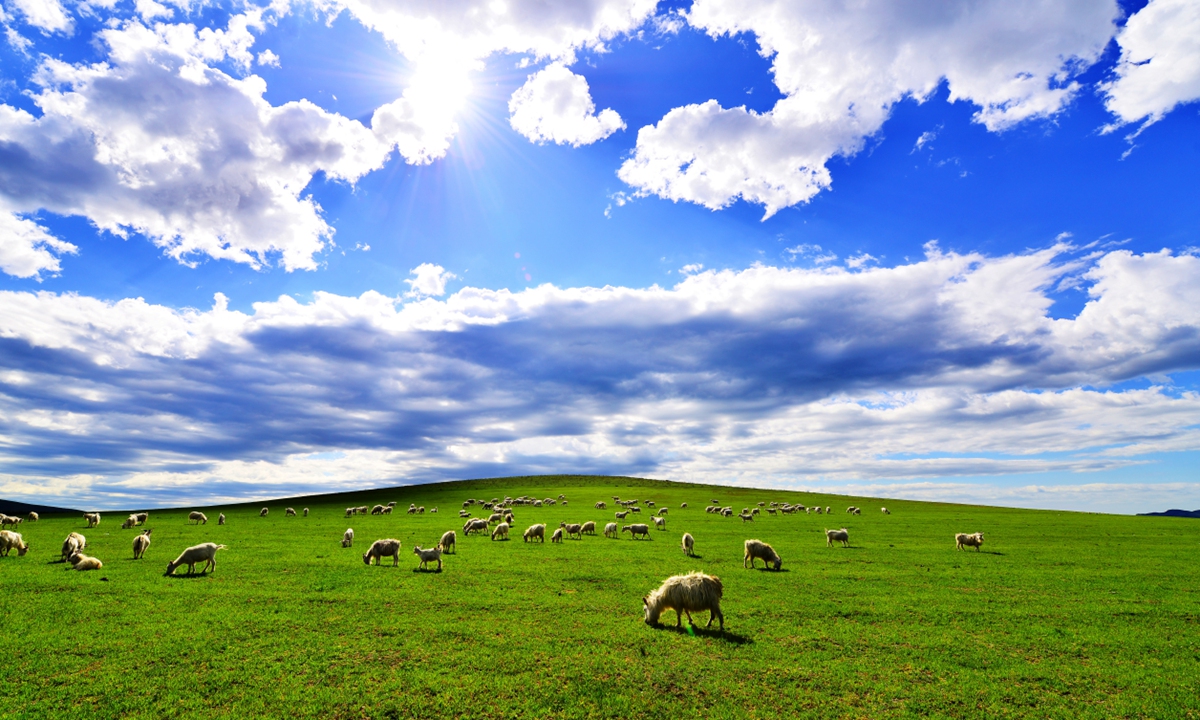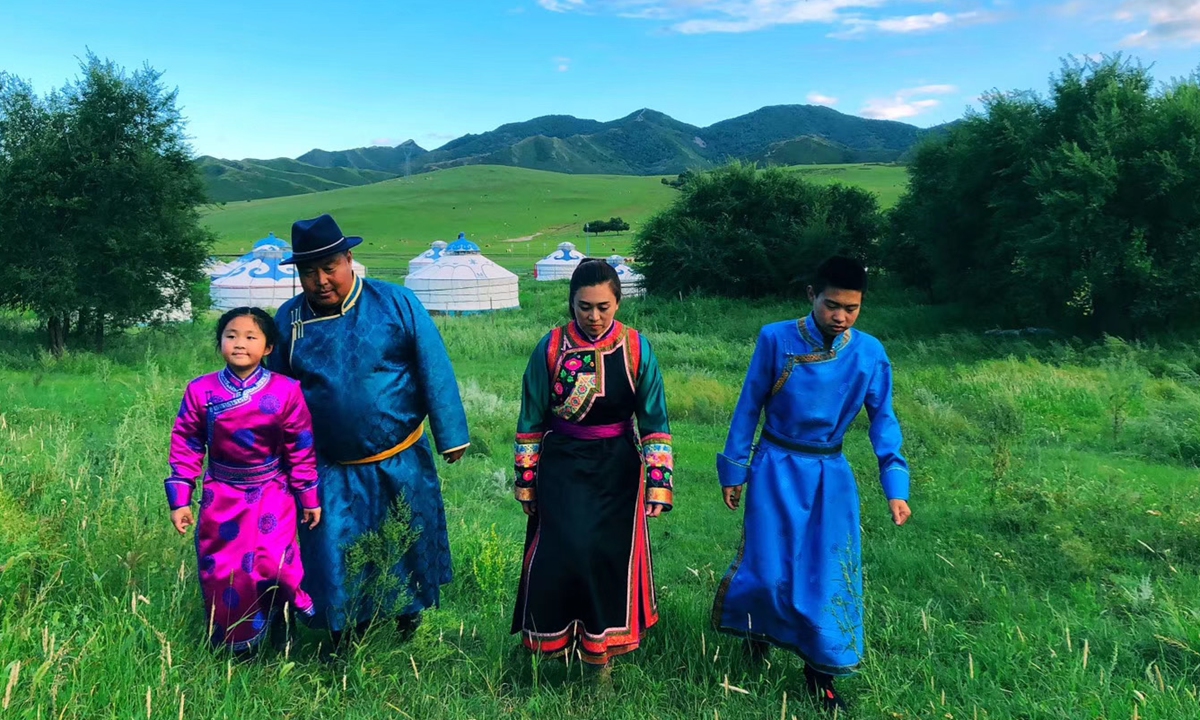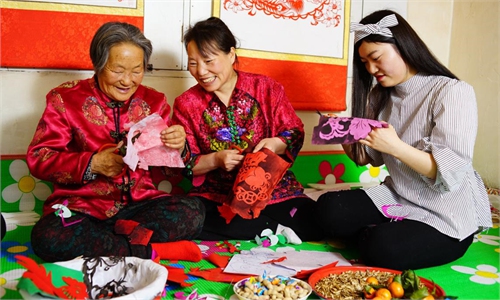IN-DEPTH / IN-DEPTH
Scientific initiatives, multiplayer efforts prove China's anti-desertification drive in Inner Mongolia stands test of time

The scenery of Horqin grassland Photo: Courtesy of Bai Guozhan
"In the past, when the wind blew in the spring, we were bound to be hit by sandstorms. As long as you went out, the crazy sand would try to get into your mouth and nose." Several massive sandstorms that recently passed through northern China have brought back heart-wrenching memories for Baijilin Baiila, a forest ranger on the Horqin grassland in North China's Inner Mongolia Autonomous Region, which also suddenly made him realize that in his hometown, the last spring like this year happened long ago.
But faced with the wider vilification of such a storm targeted at China in the Western media which portrays the sand as coming from outside China as the result of China's "ecological crisis" and the "degradation of grasslands and woodlands," Baijilin Baiila felt very angry.
"We clearly know that most of the sandstorms this year did not originate in our country, because now in Inner Mongolia, you can see greenery everywhere. Even a strong wind wouldn't blow up much sand," he told the Global Times.
From 2016 to 2020, the Inner Mongolia Autonomous Region has prevented and controlled desertification on an average of 12 million mu (800,000 hectares) per year, effectively curbing the spread of deserts.
Expert, officials, and herdsmen reached by the Global Times applauded China for courageously taking the responsibility of improving the condition of affected ecosystems and populations, guaranteeing its people's right to life and development. Under the unremitting efforts of countless Chinese people, there are fewer and fewer cases of large-scale dust storms directly generated in China. People's lives are also increasingly becoming happier.

Honggelbatel's family ramble on the grassland. Photo: Courtesy of Honggelbatel
Scientific and effective initiatives
The sea buckthorn forest, gave 54-year-old Baijilin Baiila more hope for spring. Even though his living conditions have greatly improved, he has not given up his hard work as a forest ranger, patrolling 300 acres of the forest at five o'clock every morning on his motorbike no matter the weather.
Baijilin Baiila lives in Horqin Right Wing Middle Banner of the Hinggan League, where the ecological environment was extremely fragile in the past, with desertification and salinization accounting for about 54 percent of the total landmass.
The harsh environment constrained local economic development. "We have endured years of drought, and when the wind blew, the crop fields would become nests of sand. We were even afraid to leave our homes," he said.
Fortunately, since 2016, local authorities have been pushing forward with reforestation campaigns, completing a total of 28,500 mu (1,900 hectares) of caragana microphyllaand sea buckthorn planting in 2018. In 2019, a total of 70,000 seedlings on 1500 mu (100 hectares) of sea buckthorn were added, with the survival at above 92 percent.
The data revealed that scientific tree-planting actions have built a green ecological barrier for Horqin Right Wing Middle Banner. Presently, the deforested land has been reduced from 6.11 million mu (407,333 hectares) to 710,000 mu (47,333 hectares). The comprehensive vegetation coverage rate of grassland has increased from 35.17 percent in 2016 to 63.96 percent. The annual average number of days with good air quality has also reached 332 days.
The protection forest has firmly locked the moving sands and has improved the livelihoods of local residents. In 2019, Baijilin Baiila signed up to be a forest ranger in his village, responsible for inspecting and reporting the growth of sea-buckthorn trees to the local forestry bureau. At the same time, he received a special government subsidy of 10,000 yuan ($1,556) per head of cattle. Combined with dividends from the sea-buckthorn forest and the cattle industry income, he could earn more than 50,000 yuan ($7,783) annually.
"Compared to cattle, sheep eat more grass and will eat it along with the roots, causing more ecological damage, so our government allows but discourages sheep farming and instead encourages herdsmen to raise cattle," Wang Chao, the first secretary of the Khattobuki Village told the Global Times.
In the Jaruug Banner in Tongliao, 240 kilometers away from the Horqin Right Wing Middle Banner, more than 160 calves were born in Honggelbatel's Modern Joint Family Ecological Ranch, which will bring him an annual income of approximately 2 million yuan ($310,794).
This considerable income is due to a risky decision made by Honggelbatel a few years ago.
In 2017, responding to the local government's "reducing sheep and increasing cattle" policy, Honggelbatel sold 1,000 sheep and built a more than 3,000 square meter modern standard shed to focus on developing a high-quality cattle breeding industry.
"In the past, many grasslands became wasteland because of long-term overgrazing, causing sandstorms in spring and heavy rains in summer, which resulted not only in income decrease but also in casualties. Now under the support of the government, the profit of raising one head of cattle is equal to five sheep, the grass is greener every year, and our revenue has also becomes higher," he said.
During the current spring grass growing season, Honggelbatel has been strictly following the government's zoned rotation grazing policy by temporarily confining cattle in the shed to prevent the grass from being prematurely eaten by the livestock.
According to Unen, deputy director of the Jaruug Banner, local authorities also recently set up more than 2.3 million mu (153,333 hectares) of grazing prohibition areas, establishing 12 management stations with 130 patrol personnel to provide all-round supervision and protection throughout the year.
"There has been no random grazing, or large-scale destruction of vegetation for several years because many people realized that desertification control is closely related to our vital interests, and our next generations will still live and develop on this vibrant soil in the future," Unen told the Global Times.

An ecological ranch in Horqin Right Wing Middle Banner of Hinggan League Photo: Lin Xiaoyi/GT
Multi-participant efforts
In the newly established saline land comprehensive utilization base of Yuan Longping workstation in Horqin Right Wing Middle Banner, the saline-tolerant rice grows vigorously. The machinery for synthesizing new organic fertilizers is also in full swing, which has made researchers who are determined to improve the saline-alkali land ecology brim with confidence.
Last year, a new type of rice was successfully developed by the research team of Yuan Longping, a renowned Chinese agronomist dubbed the "father of hybrid rice," producing an average yield of 533.95 kilograms per mu in the once barren, saline-alkali land.
"The saline-alkali tolerant rice can effectively curb land desertification while stimulating the sustainable development of agriculture," Wang Shigang, director of Yuan Longping Workstation of Hinggan League told the Global Times.
Wang also noted that given that the mixed farming industry is one advantageous characteristic of local industries, which also produces a large amount of straw, cattle, and sheep manure. They innovatively use the waste products, which were originally burned polluting the air, as raw materials, generating harmless, efficient, and safe organic fertilizer to improve the content of the soil's organic matter and promote the ecological restoration of saline land.
According to Wang, at present, for every kilogram of salt-tolerant rice produced, two square meters of saline-alkali land can be improved, and the income of the local residents can be increased by 0.2 yuan, in the next three years. Their workstation will cooperate with the government to open up 200,000 mu (13,333 hectares) of salt-tolerant land for rice cultivation, which is expected to increase rice yields by 100 million kilograms per year.
In 2020, the broadcast of the TV series Maple Leaf Red, which shows the natural scenery of Horqin Grassland and tells the story of local people improving the ecological environment and developing the economy by raising cattle and planting rice, helped boost the grassland eco-tourism industry.
"With less sand and greener grass, an increasing number of people are coming to the grassland for visits. We have drawn an ecological conservation red line, constructing environment-friendly film and television bases and outdoor camps, and setting up 'nature classes' to convey the notion of environmental protection to more people, which has been widely welcomed by the public," Wang Zhigang, manager of Acer Mono Ecotourism Scenic Region of China's Overseas Chinese Town (OCT) Group, told the Global Times.
Local people and tourists alike are more conscious of the effectiveness of environmental improvements. This change should also be the strongest incentive for governments and related enterprises to take practical action, Li Yulong, an expert on international human rights issues at the Party School of Central Committee of the CPC told the Global Times.
"China is one of the countries with the largest area of desertification and the largest population affected in the world. However, over the years, China has made persistent efforts to tackle the challenges of desertification and develop a path to combat sandstorms that are jointly promoted by ecological protection and the improvement of people's livelihoods," he said.
Li also pointed out that the issue of climate and environmental changes has no national boundaries, so some countries or media should not narrowly dismiss China's efforts and achievements to combat desertification due to the occasional occurrence of extreme weather. On the contrary, these issues are the common responsibility of a region or even the whole international community which should improve communication through international cooperation and face the problem together.


